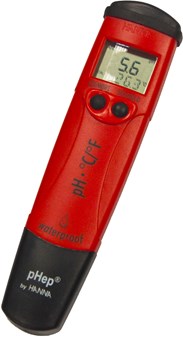Selecting pH Meters For In-House Testing


Every grower realizes the importance of growing medium pH. Growing medium pH influences the availability of nutrients to plants, especially micronutrients. The higher the pH, the less available certain elements are to plants, such as iron, manganese, boron, copper and zinc. In contrast, when pH is lowered, these elements become more available. Certain indicators crops are important for displaying micronutrient / pH symptoms - particularly calibrachoa and petunia when the growing medium pH is high and geranium when pH is low. Of course, the best way of monitoring pH is for the grower to measure it with a pH meter before it becomes problematic with a crop. Here are some pointers for selecting a pH meter and its care.
What to Avoid
There are several types of pH tools and meters. Indicator strips, such as litmus paper, only let you know if you are above or below a certain value. Pool test kits come with indicator strips that cover with multiple indicators that show the approximate pH of the sample. These may give a rough idea, but are the least accurate. Inexpensive pH meters (<$30) are simple units with protruding metal electrodes that are inserted into the root ball, however these units often give false readings and are not reliable.
Ideal Choices
The best pH meters are professional models offered by horticultural distributors. There are four types:
- The pen type that can be placed in a shirt pocket. Accuracy is good and they are a great value with a cost ranging from $100-250.
- Handheld units in which the electronic readout “box” is attached to the external electrode by a cable. Costs range from $150-$500.
- These pH meters have a cup in which a solution is poured into. These are units are accurate, durable and cost ranges from $450-$900.
- Last is the non-portable desktop unit, which is the most accurate, but is not portable and cost is often more than $1200.
All of these meters have great accuracy and work well for horticultural pH testing of growing medium, water and fertilizer solution.

Fine Tuning the Ideal Choice
Within these groups of pH meters, accuracy is better if the pH meter has a two point calibration (meaning that calibration is done at two different pH values) versus a single point. Avoid any pH meter that does not require calibration as they drift out of calibration quickly. pH meters with two point calibration typically have either two or three pH calibration options, pH 4.0 and 7.0 (most common) or pH 10 as the third option. Since most pH readings fall between 4.0 and 7.0, it makes sense to calibrate a pH meter at pH 4.0 and 7.0. This is done with calibration solutions (standards) that are manufactured to have a pH of 4.0 or 7.0. Make sure you have these pH calibration solution standards available.
Electrode Care
Most of these meters have glass bulbs that are made to be inserted into the solution / media being tested. Avoid scratching the glass on hard surfaces or on abrasive media particles. When the meter is not in use, the glass bulb needs to be stored wet, in storage solution or pH 4.0 standard solution. Do not store in tap water or distilled water. There are some pen types that do not require wet storage and also some handheld with metal electrodes that can be inserted into the root ball. The electrodes in these units will need periodic cleaning depending on how often the meter is used. Follow the manufacturer’s guidelines for electrode care. Also, avoid touching the metal electrode as it is sensitive to electrostatic discharges.
The electrodes on pH meters can last up to 2 years, depending on the amount of use and care. Purchase a meter where the electrode can be replaced. You will know that the electrode needs to be replaced when the meter cannot be calibrated with one or both calibration solutions.
General Meter Usage Tips
Regardless of the type of meter, do not store it in the greenhouse where humidity can interfere with electrical signals and shorten the life of the meter. Each meter should be calibrated at least once per day. The more frequently a meter is calibrated the more accurate the measure.
Having pH values at your fingertips allows you to make important adjustments to your crop culture to prevent problems before they occur and achieve the best crop results.